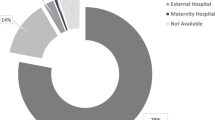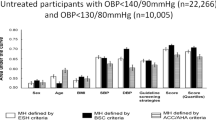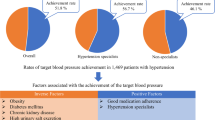Abstract
The aim of this study was to investigate the diagnostic approach to recently diagnosed hypertensive patients by primary care physicians in Italy and to find out whether general practitioners manage these patients according to 1999 WHO/ISH guideline recommendations. In total, 228 consecutive patients (117 men and 111 women, mean age 51±12 years) with recently diagnosed hypertension (<2 years) referred for the first time to six outpatient hypertension centres throughout Italy were included in the study. The primary care physicians' approach was evaluated during the specialist visit by a specific questionnaire containing detailed questions about diagnostic work-up and treatment made at the time of the first diagnosis of hypertension. At the study visit, 71% of the patients were on treatment with antihypertensive drugs and 18.7% of them had blood pressure (BP) values lower than 140/90 mmHg. A complete clinical and laboratory evaluation according to the minimum work-up suggested by the guidelines had been carried out in only 10% of the patients. A full physical examination had been performed in 60% of the patients, electrocardiogram in 54%, serum total cholesterol in 53%, glucose in 49%, creatinine in 49%, urine analysis in 46%, potassium in 42%, and fundus oculi in 19%. Additional investigations such as ambulatory BP monitoring, echocardiogram, carotid ultrasonogram, and microalbuminuria had been carried out in a minority of patients (21, 18, 9, and 3%, respectively). The impact on hypertension guidelines on patients' management in everyday primary care practice appears marginal. Thus, our findings indicate that the majority of general practitioners manage hypertensive patients according to a simple BP-based approach rather than a more integrated approach based on global risk stratification.
This is a preview of subscription content, access via your institution
Access options
Subscribe to this journal
Receive 12 digital issues and online access to articles
$119.00 per year
only $9.92 per issue
Buy this article
- Purchase on Springer Link
- Instant access to full article PDF
Prices may be subject to local taxes which are calculated during checkout

Similar content being viewed by others
References
MacMahon S et al. Blood pressure, stroke and coronary heart disease, part 1: prolonged differences in blood pressure: prospective observational studies corrected for the regression dilution bias Lancet 1990 335: 765–774
Kannel WB, Belanger AJ . Epidemiology of heart failure Am Heart J 1991 121: 951–957
He J, Whelton PK . Elevated systolic blood pressure and risk of cardiovascular and renal disease: an overview of evidence from observational epidemiologic studies and randomized controlled trials Am Heart J 1999 138: S211–S219
Collins R et al. Blood pressure, stroke and coronary heart disease, part 2: short-term reductions in blood pressure: overview of randomized drug trials in their epidemiological context Lancet 1990 325: 827–838
Hebert PR et al. Recent evidence on drug therapy of mild to moderate hypertension and decreased risk of coronary heart disease Arch Intern Med 1993 153: 578–581
Moser M, Hebert PR . Prevention of disease progression, left ventricular hypertrophy and congestive heart failure in hypertension treatment trials J Am Coll Cardiol 1996 27: 1214–1218
Hansson L et al. for the HOT Study Group. Effects of intensive blood-pressure lowering and low-dose aspirin in patients with hypertension: principal results of the Hypertension Optimal Treatment (HOT) randomised trial Lancet 1996 351: 1755–1762
Report of a WHO Expert Committee. Arterial hypertension In Technical Report Series 628 Geneva: World Health Organisation 1978
Guidelines Subcommittee. 1989. Guidelines for the management of mild hypertension: memorandum from a WHO/ISH meeting Clin Exp Hyper—Theory Prac 1989 A11: 1203–1216
Zanchetti A, Mancia G . Editor's corner: debating the value of absolute versus relative risk J Hypertens 1996 14: 681
1999 World Health Organization—International Society of Hypertension Guidelines for the Management of Hypertension. Guidelines Subcommittee. J Hypertens 1999 17: 151–183
Waeber B . Treatment strategy to control blood pressure optimally in hypertensive patients Blood Pressure 2001 10: 62–73
Hamilton-Craig CR, Tonkin AL, Jobling RG . How accurate are hypertension treatment decisions? Blood Pressure 2000 9: 323–327
Joint National Committee on Prevention, Detection, Evaluation and Treatment of High Blood Pressure. The sixth report of the Joint National Committee on Prevention, Detection, Evaluation and Treatment of High Blood Pressure Arch Intern Med 1997 157: 2413–2446
Fahey TP, Peters TJ . What constitutes controlled hypertension? Patient-based comparison of hypertension guidelines BMJ 1996 313: 93–96
Dickerson JE, Garrat CJ, Brown MJ . Management of hypertension in general practice: agreements with and variations from the British Hypertension Society guidelines J Hum Hypertens 1995 9: 835–839
Ogden LG, He J, Lydick E, Whelton PK . Long-term absolute benefit of lowering blood pressure in hypertensive patients according to JNC VI risk stratification Hypertension 2000 35: 539–543
Hyman DJ, Pavlik VA . Self-reported hypertension treatment practices among primary care physicians Arch Intern Med 2000 160: 2281–2286
Hagemeister J et al. Hypertension guidelines and their limitations. The impact of physicians' compliance as evaluated by guidelines awareness J Hypertens 2001 19: 2079–2086
Cuspidi C et al. Awareness of hypertension guidelines in general practice: a pilot study in Lombardy Ital Heart J 2002 3: 60–63
Author information
Authors and Affiliations
Consortia
Corresponding author
Rights and permissions
About this article
Cite this article
Cuspidi, C., Michev, I., Lonati, L. et al. Compliance to hypertension guidelines in clinical practice: a multicentre pilot study in Italy. J Hum Hypertens 16, 699–703 (2002). https://doi.org/10.1038/sj.jhh.1001468
Received:
Revised:
Accepted:
Published:
Issue Date:
DOI: https://doi.org/10.1038/sj.jhh.1001468
Keywords
This article is cited by
-
Effectiveness of instructional videos for enhancing healthcare provider competencies for hypertension management – a pre-post study in primary healthcare settings, Tanzania
BMC Health Services Research (2022)
-
Provider adherence to first antenatal care guidelines and risk of pregnancy complications in public sector facilities: a Ghanaian cohort study
BMC Pregnancy and Childbirth (2016)
-
Public health facility resource availability and provider adherence to first antenatal guidelines in a low resource setting in Accra, Ghana
BMC Health Services Research (2016)
-
The Neglected Role of the Electrocardiogram in the Diagnostic Work-Up of Hypertensive Patients
High Blood Pressure & Cardiovascular Prevention (2013)
-
Hypertension in an urban population – who is treated with what and how well?
Journal of Human Hypertension (2007)



